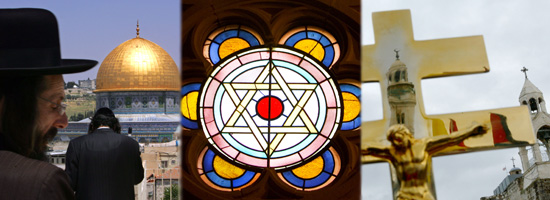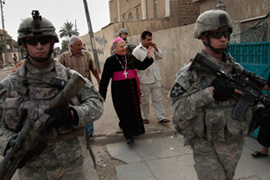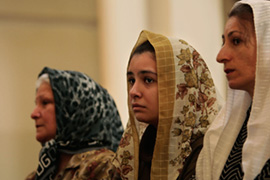In the land of Abraham
History provides many lessons of coexistence between religions in the Middle East.

 |
| The Middle East was the birthplace of all three Abrahamic religions [GALLO/GETTY] |
The Middle East, home to some of the oldest communities in the world, is the geographic area where major religious customs have coexisted as a matter of tradition for several thousand years.
Its recorded history – ancient, medieval, and modern – has documented this coexistence of hundreds of religious groups, some atheistic or agnostic, some polytheistic, and some monotheistic.
And, despite occasional polemical and even violent encounters among Middle Eastern religions, history clearly points to undeniable tolerance and maturity among the region’s communities that has gone largely unacknowledged.
Within the various Middle Eastern religious groups, monotheistic communities occupy an important position, given their large size and cultural immanence.
In simple terms, the main conditions of coexistence among Middle Eastern monotheists have been the fluidity of borders among these communities and their mixing in cultural and intellectual circles, in the government, and in the family.
Fluid borders
|
The religions of | ||
|
One must note that Middle Eastern monotheistic communities cannot simply be reduced to three categories – Jewish, Christian and Muslim.
Monotheists of partial affiliation with these three groups have lived in the Middle East at least throughout the last three millennia. Some of these communities are known as the hunafa (those who follow the path of Abraham) and have lived in Arabia since around the time of the rise of Islam.
More importantly, the borders among these and other monotheistic communities enjoy a considerable degree of fluidity. Some old Christian communities were indistinguishable from their contemporary Jewish communities who lived in their vicinity.
Borderline communities (people who claimed both Jewish and Christian heritage, for example) survive today, such as the Nasranis and St Thomas Christians who claim a mixed Syrian Jewish Christian heritage and live mostly in India.
The differences within Jewish communities have been just as significant (or insignificant) as the differences between these and Christian communities at various points.
These groups experienced shifts of convergence and divergence – some small religious groups were unified into larger groups, and some branched into smaller ones.
Islam and monotheists
The rise of Muslim communities in the midst of Jewish, Christian, and other monotheistic communities, added another element to the picture. The early Muslim communities were inevitably influenced by the older monotheists in their beliefs and practices.
Islam has embraced monotheism in general and specific terms. Both the Quran and the Prophet Muhammad’s adages praise Jewish and Christian communities, as they do non-Jewish, non-Christian monotheists.
The Quran (Surah 2: Verse 136), for example, shows that the declaration of faith for all Muslims includes belief in all the prophets:
“We believe in God, and in that which has been bestowed from on high upon us, and that which has been bestowed upon Abraham and Ishmael and Isaac and Jacob and their descendants, and that which has been vouchsafed to Moses and Jesus; and that which has been vouchsafed to all the [other] prophets by their Sustainer: we make no distinction between any of [these prophets].”
The linguistic-cultural map
 |
| Iraqi Christians attend mass at a Baghdad church [GALLO/GETTY] |
The same patterns of convergence and coexistence are also reflected in the linguistic map of the Middle East.
Syriac and Syro-Aramaic (Syrian varieties of Aramaic) represent a convergence between Jewish and Christian communities east of the Mediterranean and north of the Arabian Peninsula.
The adoption of Arabic by many Middle Eastern communities added to their ability to share a significantly unified cultural world.
Medieval Jewish communities developed Judeo-Arabic (Arabic written in Hebrew letters) to address the constant interaction between the Jewish communities and their Arab surroundings.
Aside from these hybrid linguistic formations, Middle Eastern languages have continued to borrow heavily from one another, creating a natural bridge for the exchange of ideas and cultural activities.
Middle Eastern intelligentsia
The production of knowledge in the Middle East, especially in the Middle Ages, fostered religious coexistence by defying simple affiliation with the labels “Arab” or “Muslim”.
Medieval Middle Eastern philosophy, generally defined as an umbrella of the natural and human sciences, could be called Islamic or Arabic, given the role Islam played in it and given the religious diversity of those who participated in it.
In this environment, major Muslim philosophers, such as Farabi (d. 950), boasted of their education at the hands of Christian mentors.
Major Islamic philosophers, such as Kindi (d. 873) and Rhazes (d. 925), did not hold orthodox Muslim beliefs. Major medieval Jewish intellectuals, such as Sa’dia Ga’on (d. 942), Yahuda Bin Halevi (d. 1141), and Moses Maimonides (d. 1204), were conversant in Islamic philosophy and mysticism.
Scientific co-operation and path-crossing also pervaded the areas of the natural sciences and medicine, among other areas of knowledge in the medieval world.
Government and family
But coexistence could not have been fostered and secured had it not been for the roles of government and the family.
Aside from intellectual circles, the political and social spheres reveal a similar pattern of harmony and unison. Jews and Christians held positions of influence in Muslim governments, spanning the functions of political advisers, city planners, state emissaries, courtiers, secretaries, scribes and translators, technical assistants, and personal physicians for the heads of state and their families.
In the social sphere, intermarriage across religious groups was almost as common as marriage within the same religious group at different points in history.
Dietary laws observed by one spouse did not have to be observed by the other spouse who was of a different religion (a Christian wife could consume pork in the house of her Muslim husband, for example). Thus, mutual respect prevailed, and coexistence flourished.
Abrahamic communities
 |
| The Middle East is now described as the region where coexistence is hardest [GALLO/GETTY] |
Ironically, as it becomes fashionable to speak of a world-wide Abrahamic community, consisting of Jewish, Christian, and Muslim communities, the Middle East, with its historically privileged position as the birthplace of these faiths and the theatre of their longest interaction, is described as a troubled region – one where coexistence among these same religious communities is hardest.
This is a bit counterintuitive as well as counter-historical. Middle Eastern Jews, Christians, and Muslims are the natural nucleus of a world-wide Abrahamic community, since Abraham, the father of all monotheists, is revered by all three religions, and the Middle East is the birthplace of Abraham and all three religions.
The cross-cultural, cross-civilisational Abrahamic community could only claim to continue the tradition of coexistence among Middle Eastern monotheistic communities, with an ambitious (and laudable) goal of transcending race, economic background, and cultural sensibilities.
History can provide many lessons of coexistence and co-operation among Middle Eastern populations. These examples must be used as a bridge for contemporary Middle Eastern communities to build a more tolerant world for themselves and as an example to be followed by the rest of humanity.
Ahmad Atif Ahmad is an assistant professor of Islamic studies at the University of California, Santa Barbara.
